Blogs
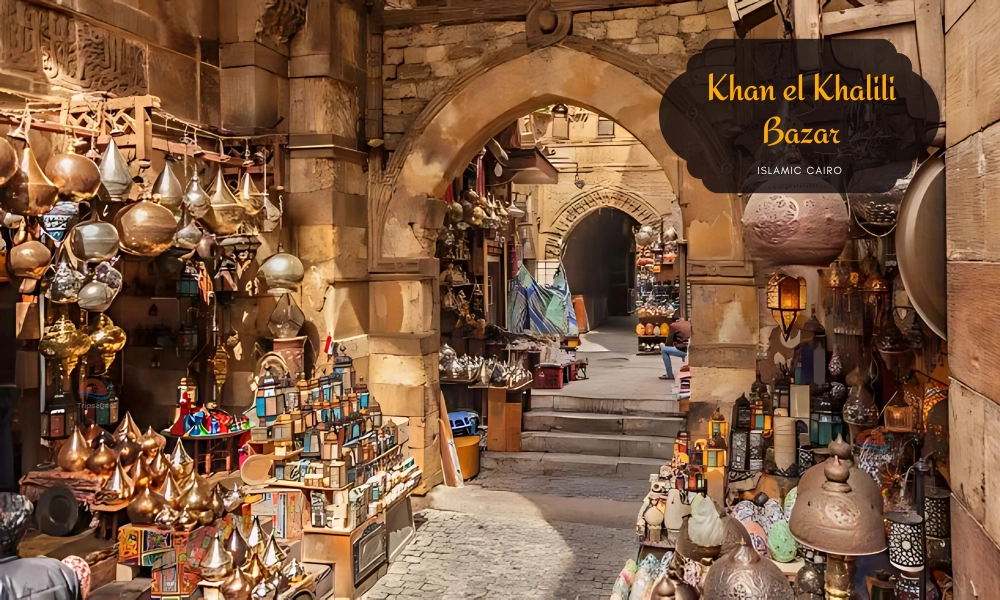
Khan el-Khalili Bazar
Nestled in the heart of Islamic Cairo lies one of the world’s oldest and most enchanting marketplaces, Khan el-Khalili. More than just a bazaar, it’s a living museum of Egypt’s history, culture, and craftsmanship. With its labyrinthine alleys, centuries-old mosques, vibrant stalls, and the aroma of spices wafting through the air, Khan el-Khalili offers a truly immersive experience that captivates locals and travelers alike.
Khan el-Khalili provides an amazing trip into Egypt's past and present, whether you're looking for unusual presents or just want to take in the vibrant atmosphere.
Table of Contents
- 1. Why Khan el-Khalili is a Must-Visit in Cairo:
- 2. The Origins of Khan el-Khalili:
- 3. A Walk Through Architecture and Design:
- 4. From Ottoman Rule to Colonial Influence:
- 5. Cultural and Commercial Highlights:
- 6. What to Buy at Khan el-Khalili:
- 7. The Spirit of the Souk:
- 8. Khan el-Khalili Today:
- 9. Visitor Tips: Make the Most of Your Experience
- 10. Conclusion: A Souk That Speaks Through Centuries
1. Why Khan el-Khalili is a Must-Visit in Cairo:
If you're looking for an authentic Egyptian experience that brings together history, shopping, cuisine, and culture in one unforgettable location, Khan el-Khalili is your go-to destination. This bustling souk is:
- A hub of traditional craftsmanship and artisanal heritage
- Home to historical cafés and centuries-old Islamic architecture
- A lively marketplace that offers both everyday goods and rare finds
- The perfect place for cultural interaction and local storytelling.
- Visitors can experience the vibrant energy of Cairo's street life by strolling through the busy alleys, complete with the sounds of local music, the calls of vendors, and the aroma of exotic spices.
Whether you’re in Cairo for a few days or weeks, Khan el-Khalili is a must-see attraction that reflects the soul of Egypt.
2. The Origins of Khan el-Khalili:
The bazaar was founded in the late 14th century by Emir Djaharks el-Khalili, a Mamluk nobleman who established it over an ancient Fatimid burial ground. Cairo during the 1300s was a powerful economic and cultural center, known as the “City of a Thousand Minarets.” As trade between Africa, the Middle East, and Europe boomed, Khan el-Khalili quickly became the nucleus of commercial activity in the Islamic world.
Key Highlights from the Mamluk Era
- Emerged as a caravanserai: a safe lodging spot for traders and merchants.
- Became a melting pot of cultures, products, and languages.
- Cemented Cairo’s position as a key player in the Silk and Spice Routes.
3. A Walk Through Architecture and Design:
Stepping into Khan el-Khalili is like entering a medieval time capsule. The architecture is a rich blend of Mamluk, Ottoman, and Islamic styles, with arched entryways, intricate woodwork, and beautiful minarets lining the skyline.
Beautiful examples of Mamluk and Ottoman architecture can be found in many buildings. These structures are distinguished by their elaborately decorated wooden screens (mashrabiya), exquisitely arched doorways, and intricate stone carvings.
Notable Features:
- Narrow cobbled alleys crisscrossed by hanging lanterns
- Mashrabiyas (latticework balconies) overlooking the streets
- Historic Mosques Nearby:
- Al-Hussein Mosque: one of the most revered Islamic sites
- Al-Azhar Mosque: home to the oldest Islamic university in the world
The structural beauty and urban layout of the bazaar provide insight into how ancient markets were not just for trade but also for social and cultural exchanges. Khan el-Khalili is a living museum of Islamic art and urban design because of its rich architectural diversity, which also connects visitors to Cairo's complex past.
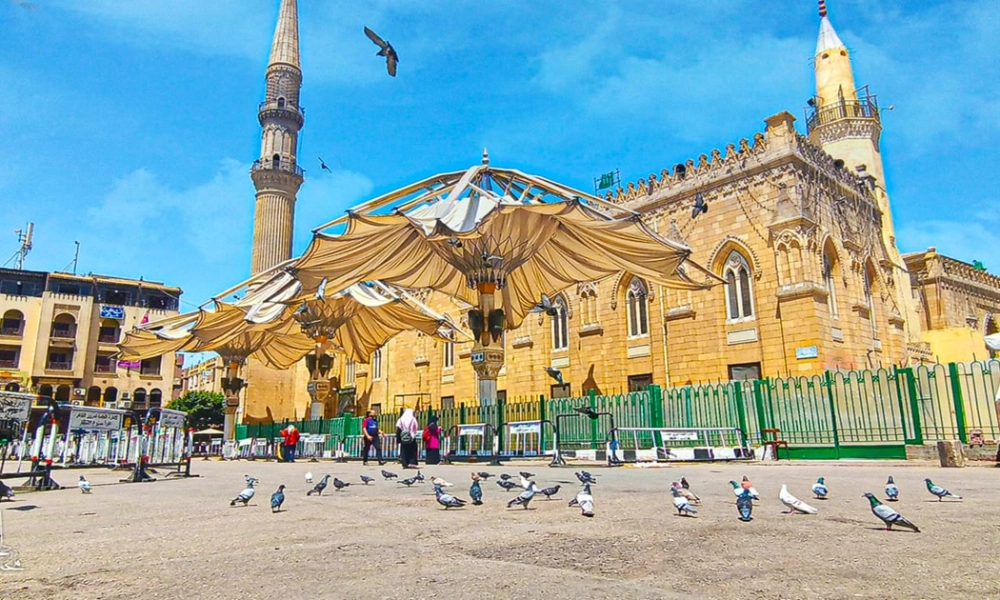
4. From Ottoman Rule to Colonial Influence:
Khan el-Khalili’s long-standing legacy was deeply shaped by the tides of empire and colonial presence. During the Ottoman era (1517–1798), the bazaar flourished as a key trading post within a vast imperial network. Goods poured in from across Istanbul, Persia, and North Africa, while skilled artisans brought new craftsmanship, textures, and aesthetics. The souk became a melting pot of Islamic art, culture, and commerce.
With the arrival of the British in the late 19th century, the market embraced European imports, reflecting Cairo’s growing colonial ties. This era introduced a compelling fusion of Eastern tradition and Western trends.
5. Cultural and Commercial Highlights:
- Ottoman silverware and hand-engraved copper trays with intricate calligraphy
- Persian spices, silks, and glazed ceramics that added exotic flavor and color
- North African leather goods, including belts, slippers, and bags
- Victorian jewelry, lace hand fans, and colonial-style lanterns
- European perfumes, pocket watches, crystalware, and fine textiles
This dynamic blend of East and West transformed Khan el-Khalili into one of the most eclectic and storied marketplaces in the Islamic world.
6. What to Buy at Khan el-Khalili:
The bazaar offers an unmatched shopping experience where every item tells a story. Here's a curated list of must-buy items:
Traditional Egyptian Goods:
- Papyrus Art: Hand-painted replicas of ancient hieroglyphics
- Khan jars and pottery: Classic, handcrafted pieces
- Brass and copper lamps: Intricate and beautifully detailed
Jewelry & Textiles:
- Gold and silver jewelry: Both Bedouin and modern styles
- Handwoven scarves and galabeyas: Traditional Egyptian garments
- Leather goods: Hand-tooled bags, wallets, sandals, and belts crafted with skilled workmanship. Each item reflects generations of craftsmanship and storytelling that have been passed down for centuries.
Aromatics and Spices
- Essential oils and perfumes: Traditional attars and essential oils, often made from flowers and herbs, like lotus, amber, and jasmine, are available in beautifully decorated bottles
- Herbal teas and spices: The market is well-known for its fragrant spices, which include saffron, cumin, cinnamon, and dried herbs. These are ideal for bringing the tastes of Egypt home.
Famous Cafés and Street Food
When your feet get tired, follow the scent of fresh mint tea and roasted coffee to one of the oldest cafés in Cairo.
El Fishawy Café – Est. 1773
Known as “the café that never sleeps,” El Fishawy has hosted scholars, artists, and celebrities for over two centuries. With antique mirrors, flickering lanterns, and wooden décor, it’s the perfect spot for relaxation and people-watching.
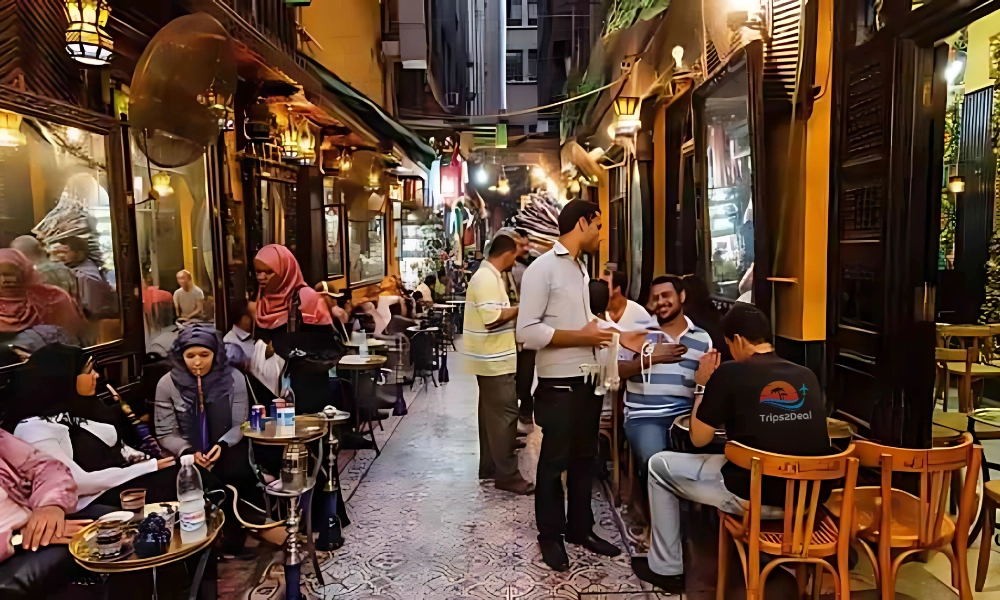
The café Naguib Mahfouz, named for the Egyptian author who won the Nobel Prize, is a great place to unwind with a cup of tea or coffee while surrounded by art and culture.
Street Food to Try:
- Koshari: A delicious mix of lentils, rice, pasta, and tomato sauce
- Taameya (Egyptian falafel): Made with fava beans, not chickpeas
- Basbousa & Kunafa: Sweet treats soaked in syrup
- Mint tea or hibiscus juice: Traditional local beverages
The culinary experience at Khan el-Khalili is just as rewarding as the shopping and sightseeing.
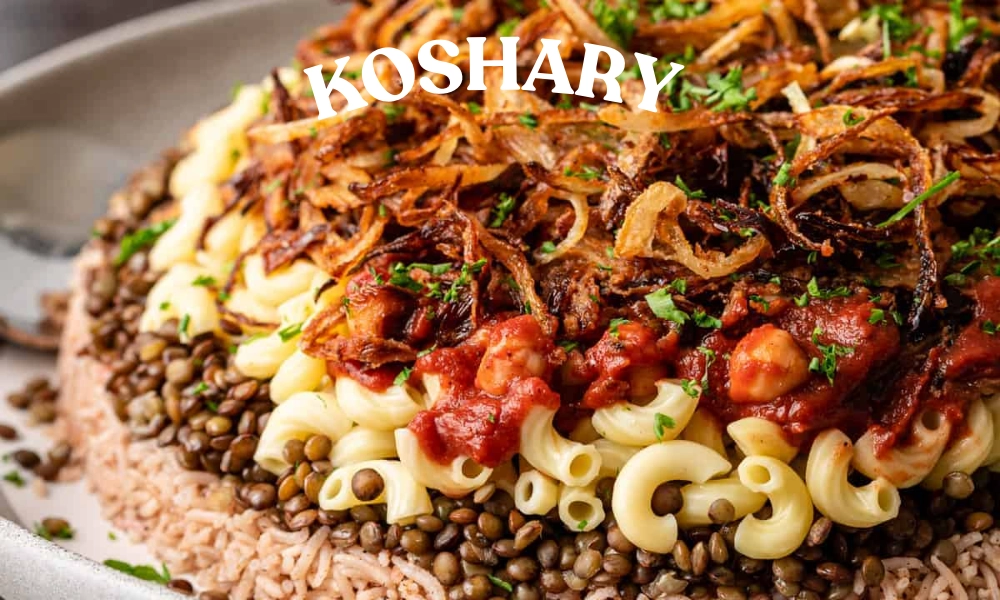
7. The Spirit of the Souk:
Beyond the goods and glitter, what truly defines Khan el-Khalili is its heartbeat, the people. Vendors here are far more than shopkeepers; they are storytellers, artisans, and guardians of centuries-old traditions. Conversations flow as easily as tea is poured. Many sellers have inherited their stalls through generations, and with each item sold, they pass along a slice of Cairo’s living history. It’s not unusual to hear tales of ancient traders, neighborhood legends, or family recipes whispered between sales.
Tips on Interacting:
- Haggling is a ritual, not a battle: Although haggling is normal, it should be done politely and with a sense of humor. Steer clear of confrontational or aggressive approaches; a cordial negotiation frequently produces better outcomes. Start low, smile often, and enjoy the playful exchange.
- Learn a few Arabic phrases: Simple words like "shukran" (thank you) or "kam el-thaman?" (how much?) goes a long way.
- Ask questions and listen: Many vendors are proud to share the origin of their goods and the traditions behind them.
- Accept hospitality: A cup of hibiscus tea or Turkish coffee is more than a drink, it’s a gesture of welcome.
- Take your time: The souk rewards curiosity and connection over quick transactions.
- Respect Local Customs: To demonstrate cultural sensitivity, dress modestly and refrain from acting too familiar, especially toward women.
- Engage with pride: Show Genuine Interest and Appreciation: A lot of vendors are enthusiastic about what they do and love to share stories about their goods.
- Ask Before Photographing: To respect privacy and local customs, always get permission before taking pictures of people or inside businesses.
- Be Warm and Courteous: Courtesy and warmth are highly valued by Egyptians. Smile as you greet vendors and strike up a conversation with a kind greeting like "Salam Alaikum" (peace be upon you).
8. Khan el-Khalili Today:
While modernization has made its mark, Khan el-Khalili still retains its ancient soul. Tourist demand has led to an increase in commercial items, but artisanal stalls and traditional workshops continue to thrive. Along with residents, the area draws a constant flow of tourists who want to take in the vibrant atmosphere, shop for one-of-a-kind items, and learn about Egyptian culture. Many stores have broadened their selection to accommodate a variety of tastes by adding contemporary goods in addition to traditional handicrafts.
Modern Realities:
- Government efforts to preserve heritage sites and local crafts
- Cultural preservation vs. commercialization: A balancing act
- Vital role in Egypt’s tourism economy: A top destination for international and regional travelers
Despite the influx of mass-produced souvenirs, the essence of the souk lives on through the craftsmen who keep Egypt’s traditions alive. In general, Khan el-Khalili is a timeless bazaar in the center of Cairo where history, culture, and daily life continue to converge. It is a vibrant blend of the past and present.
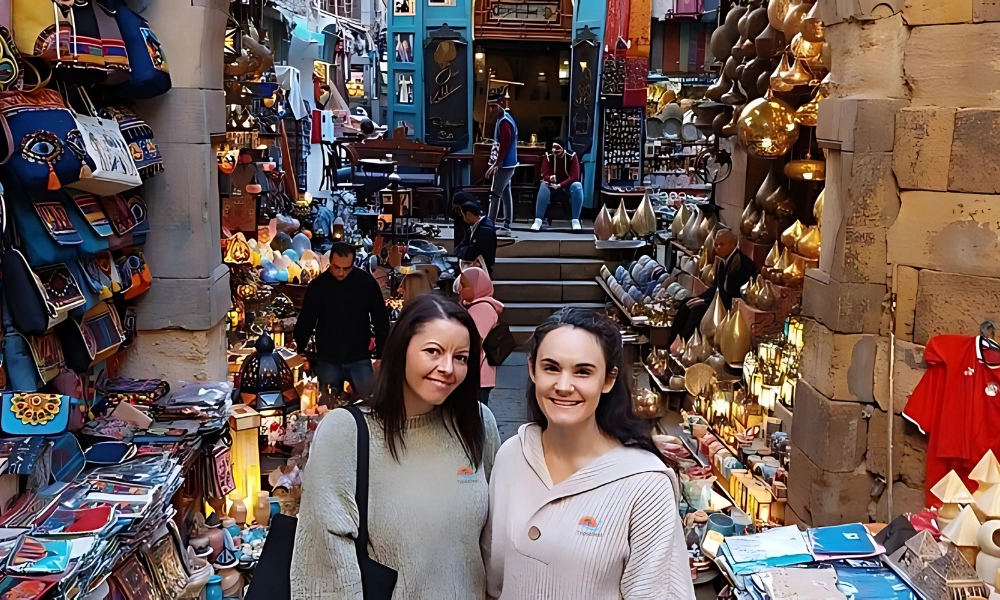
Events, Entertainment & Nightlife
As night falls, Khan el-Khalili transforms into a glowing theater of lights, music, and movement.
Evening Delights:
- Live oud and tabla performances fill the alleys with soulful rhythms and spontaneous joy.
- Wekalet El Ghouri hosts mesmerizing Sufi Tanoura dance shows that whirl with color and devotion.
- Al-Muizz Street dazzles with illuminated Islamic monuments and intricately restored historic façades.
- Ramadan Nights & Festivals: The souk sparkles with lanterns, laughter, storytelling, and late-night feasts.
- Evening visits offer a dramatic, romantic ambiance beneath Cairo’s starlit sky.
- Perfect for couples, culture lovers, artists, and photographers seeking Cairo’s timeless nighttime charm.
Many tourists like to end their day with a shisha (hookah) session or a cup of mint tea in the welcoming cafés that stay open late. All things considered, Khan el-Khalili is a fascinating place to visit day or night because of the way its evenings combine history, music, and social life. Experience unforgettable nights wrapped in tradition and wonder.
9. Visitor Tips: Make the Most of Your Experience
To get the best from your Khan el-Khalili visit, keep these practical tips in mind:
- When to Go:
- Morning to early afternoon: Quieter for sightseeing and photos
- Evening: Buzzing with energy, music, and nightlife
- What to Wear: Dress modestly and comfortably
- Etiquette: Greet vendors with “Salam Alaikum,”
- Caution: Stay aware of pickpockets; carry small bills for easier bargaining
- Negotiation Tip: Begin at 50% of the asking price and work your way up.
- Try Local Cuisine: To experience real Egyptian flavors, don't miss trying street food and going to traditional cafés.
- Employ a Guide: If you want to learn more about the market's past and undiscovered treasures, think about working with an experienced local guide.
- Keep Hydrated: Bring a bottle of water with you to stay hydrated while you explore the busy market, especially in the warmer months.
- Respect Photography Rules: Since some vendors prefer privacy, always get permission before taking pictures of people or inside specific establishments.
10. Conclusion: A Souk That Speaks Through Centuries
Khan el-Khalili is not merely a marketplace; it is the living soul of Cairo. With every step through its timeworn alleys, you walk through centuries of history, hear the whispers of ancient traders, and witness the artistry of generations past. The vibrant tapestry of sights, sounds, and scents weaves a sensory journey that lingers long after you leave.
For travelers seeking more than monuments and museums, Khan el-Khalili offers an experience rooted in authenticity and human connection. So when you visit Egypt, don’t just shop, immerse yourself. Lose yourself in the maze of stalls, exchange stories with spirited vendors, sip tea beneath the glow of hanging lanterns, and leave not just with souvenirs, but with timeless memories etched into your journey.
Don't just visit, immerse. Explore Cairo’s rich cultural heritage and make Khan el-Khalili a highlight of your Egyptian adventure.
Start planning your Cairo experience now by booking your slot through Trips2Deal.com, and unlock exclusive guided tours, curated cultural experiences, and insider access to Egypt’s most enchanting souk.





